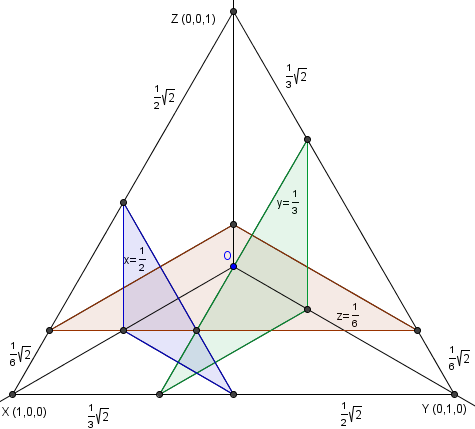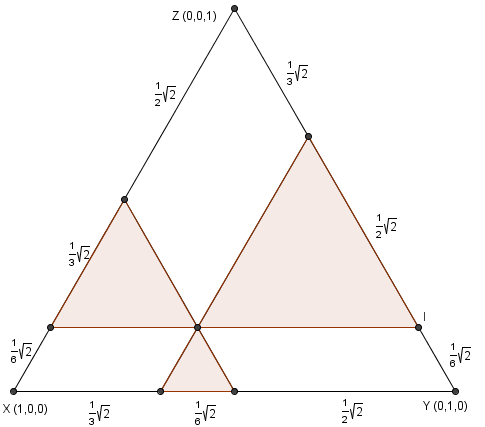Difference between revisions of "1999 AIME Problems/Problem 8"
m (→Solution: typo fix) |
m (→Solution: typo #2) |
||
| Line 11: | Line 11: | ||
[[Image:1999_AIME-8a.png]] | [[Image:1999_AIME-8a.png]] | ||
| − | The side length of the large equilateral triangle is <math>\sqrt{2}</math>, which we can find using 45-45-90 <math>\triangle</math> with the axes. Using the formula <math>A = \frac{s^2\sqrt{3}}{4}</math> for [[equilateral triangle]]s, the area of the large triangle is <math>\frac{(\sqrt{2})^2\sqrt{3}}{4} = \frac{\sqrt{3}}{2}</math>. Since the lines of the smaller triangles are [[parallel]] to those of the large triangle, by corresponding angles we see that all of the triangles are [[similar triangles|similar]], so they are all | + | The side length of the large equilateral triangle is <math>\sqrt{2}</math>, which we can find using 45-45-90 <math>\triangle</math> with the axes. Using the formula <math>A = \frac{s^2\sqrt{3}}{4}</math> for [[equilateral triangle]]s, the area of the large triangle is <math>\frac{(\sqrt{2})^2\sqrt{3}}{4} = \frac{\sqrt{3}}{2}</math>. Since the lines of the smaller triangles are [[parallel]] to those of the large triangle, by corresponding angles we see that all of the triangles are [[similar triangles|similar]], so they are all equilateral triangles. We can solve for their side lengths easily by subtraction, and we get <math>\frac{\sqrt{2}}{6}, \frac{\sqrt{2}}{3}, \frac{\sqrt{2}}{2}</math>. Calculating their areas, we get <math>\frac{\sqrt{3}}{8}, \frac{\sqrt{3}}{18}, \frac{\sqrt{3}}{72}</math>. The [[ratio]] <math>\frac{\mathcal{S}}{\mathcal{T}} = \frac{\frac{9\sqrt{3} + 4\sqrt{3} + \sqrt{3}}{72}}{\frac{\sqrt{3}}{2}} = \frac{14}{36} = \frac{7}{18}</math>, and the answer is <math>m + n = \boxed{025}</math>. |
To simplify the problem, we could used the fact that the area ratios are equal to the side ratios squared, and we get <math>\left(\frac{1}{2}\right)^2 + \left(\frac{1}{3}\right^2 + \left(\frac{1}{6}\right)^2 = \frac{14}{36} = \frac{7}{18}</math>. | To simplify the problem, we could used the fact that the area ratios are equal to the side ratios squared, and we get <math>\left(\frac{1}{2}\right)^2 + \left(\frac{1}{3}\right^2 + \left(\frac{1}{6}\right)^2 = \frac{14}{36} = \frac{7}{18}</math>. | ||
Revision as of 15:34, 15 October 2007
Problem
Let ![]() be the set of ordered triples
be the set of ordered triples ![]() of nonnegative real numbers that lie in the plane
of nonnegative real numbers that lie in the plane ![]() Let us say that
Let us say that ![]() supports
supports ![]() when exactly two of the following are true:
when exactly two of the following are true: ![]() Let
Let ![]() consist of those triples in
consist of those triples in ![]() that support
that support ![]() The area of
The area of ![]() divided by the area of
divided by the area of ![]() is
is ![]() where
where ![]() and
and ![]() are relatively prime positive integers, find
are relatively prime positive integers, find ![]()
Solution
This problem just requires a good diagram and strong 3D visualization.
The region in ![]() where
where ![]() is that of a little triangle on the bottom of the above diagram, of
is that of a little triangle on the bottom of the above diagram, of ![]() is the triangle at the right, and
is the triangle at the right, and ![]() the triangle on the left, where the triangles are coplanar with the large equilateral triangle formed by
the triangle on the left, where the triangles are coplanar with the large equilateral triangle formed by ![]() . We can check that each of the three regions mentioned fall under exactly two of the inequalities and not the third.
. We can check that each of the three regions mentioned fall under exactly two of the inequalities and not the third.
The side length of the large equilateral triangle is ![]() , which we can find using 45-45-90
, which we can find using 45-45-90 ![]() with the axes. Using the formula
with the axes. Using the formula ![]() for equilateral triangles, the area of the large triangle is
for equilateral triangles, the area of the large triangle is ![]() . Since the lines of the smaller triangles are parallel to those of the large triangle, by corresponding angles we see that all of the triangles are similar, so they are all equilateral triangles. We can solve for their side lengths easily by subtraction, and we get
. Since the lines of the smaller triangles are parallel to those of the large triangle, by corresponding angles we see that all of the triangles are similar, so they are all equilateral triangles. We can solve for their side lengths easily by subtraction, and we get ![]() . Calculating their areas, we get
. Calculating their areas, we get ![]() . The ratio
. The ratio  , and the answer is
, and the answer is ![]() .
.
To simplify the problem, we could used the fact that the area ratios are equal to the side ratios squared, and we get $\left(\frac{1}{2}\right)^2 + \left(\frac{1}{3}\right^2 + \left(\frac{1}{6}\right)^2 = \frac{14}{36} = \frac{7}{18}$ (Error compiling LaTeX. Unknown error_msg).
See also
| 1999 AIME (Problems • Answer Key • Resources) | ||
| Preceded by Problem 7 |
Followed by Problem 9 | |
| 1 • 2 • 3 • 4 • 5 • 6 • 7 • 8 • 9 • 10 • 11 • 12 • 13 • 14 • 15 | ||
| All AIME Problems and Solutions | ||











